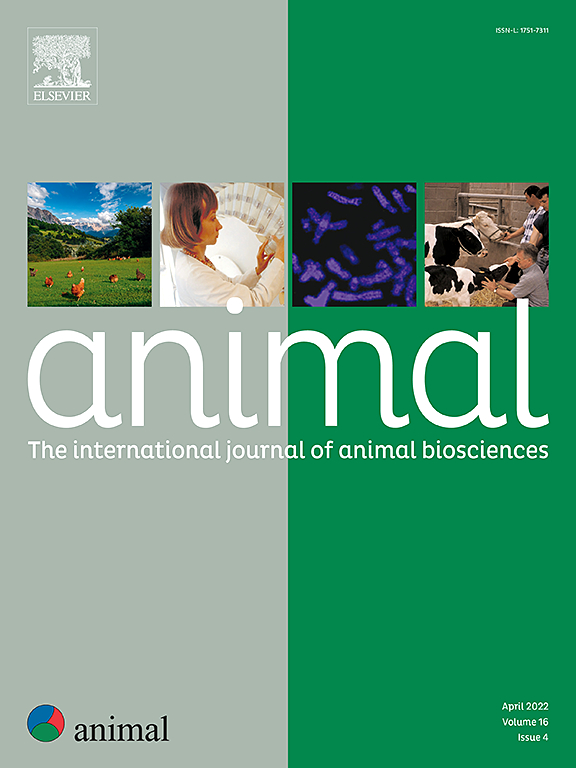放牧温带半天然草地的奶牛的氮排泄和利用情况。
IF 4
2区 农林科学
Q1 AGRICULTURE, DAIRY & ANIMAL SCIENCE
引用次数: 0
摘要
依赖于放牧的温带牧草日粮与平衡的厩饲日粮相比,容易通过尿液流失更多的氮素(N),从而造成更大的氮排放风险。在以放牧为基础的奶牛饲养系统中,提高氮利用率的措施主要是在牧草产量高、营养质量好的同质苜蓿-黑麦草牧场上进行研究。相比之下,以半天然草地为主要饲料来源、依赖较少外部投入(如合成肥料或精料)的放牧系统(如中欧大部分地区)受到的关注较少。因此,我们在德国南部的九个商业有机奶牛场调查了低投入奶牛场放牧奶牛的氮利用和排泄情况,每个牧场调查一至四个时期。数据集涵盖了不同的奶牛生产系统,包括 323 个动物个体观测数据。平均(± 1 SD)产奶量、DM 摄入量(DMI)和牧草 DMI 分别为 23.9 千克(± 5.35)、21.0 千克(± 3.21)和 11.3 千克/天(± 4.83)。用二氧化钛和粪便中的 CP 浓度分别作为粪便排泄量和日粮消化率的指标来估算采食量。牛奶氮利用效率(MNE;即牛奶氮分泌量占氮摄入量的比例)平均为 24.7 克/100 克氮摄入量(± 5.91),高于在温带高投入放牧系统中的观测值,但低于在牛舍中接受均衡日粮的奶牛。MNE和其他七项氮利用和排泄指标的数值差异很大。因此,通过反向排除法确定了解释这种差异的放牧管理因素。补饲策略在控制奶牛氮利用率和排泄量方面潜力最大。增加新鲜牧草(即草甸草或苜蓿-禾本科牧草)和干草在补饲日粮中的比例可提高氮利用率(如MNE)并减少尿氮排泄(如尿氮肌酐比),而增加精料在补饲日粮中的比例则可降低氮通过尿液的损失。与此同时,总补饲日粮的增加降低了氮的利用率,增加了尿中氮的排泄量。因此,对于氮损失水平适中的低投入、以放牧为主的奶牛场来说,全放牧结合在牛舍中补充新鲜牧草和干草是一种可行的选择。本文章由计算机程序翻译,如有差异,请以英文原文为准。
Nitrogen excretion and utilisation of dairy cows grazing temperate semi-natural grasslands
Diets reliant on grazed, temperate herbage are prone to greater nitrogen (N) losses via urine than balanced stall-fed diets which poses a greater risk for N emissions. Measures for improving the N utilisation in grazing-based dairy cattle systems are predominantly investigated on homogenous clover-ryegrass pastures with high herbage yields and nutritional quality. In contrast, grazing-based systems reliant on less external inputs (e.g., synthetic fertilisers or concentrates) using semi-natural grassland as main feed source, such as in large parts of Central Europe, received less attention. The N utilisation and excretion of grazing cows in low-input dairy farms were, thus, investigated on nine commercial organic dairy farms in South Germany across one to four periods per farm. The dataset captured a diverse set of dairy production systems comprising 323 individual animal observations. A mean (± one SD) milk production, DM intake (DMI), and pasture DMI of 23.9 kg (± 5.35), 21.0 kg (± 3.21), and 11.3 kg/d (± 4.83), respectively, was determined. Feed intake was estimated using titanium dioxide and faecal CP concentration as markers of faecal excretion and diet digestibility, respectively. Milk N use efficiency (MNE; i.e., milk N secretion as share of N intake) averaged 24.7 g/100 g N intake (± 5.91), which is greater than observations in temperate, high-input grazing systems but lower than in cows receiving balanced diets in the barn. The MNE and another seven indicators of N utilisation and excretion displayed a wide range of values. The grazing management factors explaining this variation were, thus, identified via backward elimination. The supplementation strategy had the greatest potential for manipulating N utilisation and excretion of dairy cows. Increasing shares of fresh forages (i.e., meadow grass or clover-grass leys) as well as of hay in supplement DMI increased N utilisation (e.g., MNE) and decreased urinary N excretion (e.g., urinary N to creatinine ratio), while increasing shares of concentrates in supplement DMI are related to lower N losses via urine. At the same time, increases in total supplement DMI reduced N utilisation and increased urinary N excretion. Hence, full-time grazing combined with supplementation of fresh forage and hay in the barn is a viable option for low-input, grazing-based dairy operations with moderate levels of N losses.
求助全文
通过发布文献求助,成功后即可免费获取论文全文。
去求助
来源期刊

Animal
农林科学-奶制品与动物科学
CiteScore
7.50
自引率
2.80%
发文量
246
审稿时长
3 months
期刊介绍:
Editorial board
animal attracts the best research in animal biology and animal systems from across the spectrum of the agricultural, biomedical, and environmental sciences. It is the central element in an exciting collaboration between the British Society of Animal Science (BSAS), Institut National de la Recherche Agronomique (INRA) and the European Federation of Animal Science (EAAP) and represents a merging of three scientific journals: Animal Science; Animal Research; Reproduction, Nutrition, Development. animal publishes original cutting-edge research, ''hot'' topics and horizon-scanning reviews on animal-related aspects of the life sciences at the molecular, cellular, organ, whole animal and production system levels. The main subject areas include: breeding and genetics; nutrition; physiology and functional biology of systems; behaviour, health and welfare; farming systems, environmental impact and climate change; product quality, human health and well-being. Animal models and papers dealing with the integration of research between these topics and their impact on the environment and people are particularly welcome.
 求助内容:
求助内容: 应助结果提醒方式:
应助结果提醒方式:


